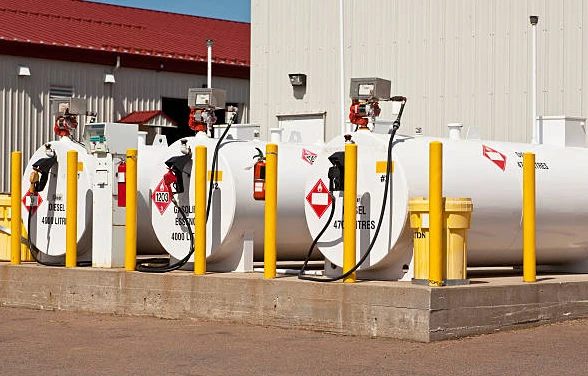Why Fuel Tanks Fail Without Visible Warning
Fuel storage tanks operate quietly for years, which is why deterioration often goes unnoticed until it becomes serious. Internal corrosion, sludge buildup, seam fatigue, moisture intrusion, and structural shifts can all develop long before any outward signs appear. Without a scheduled fuel tank inspection, many of these issues stay hidden until they lead to leaks, equipment shutdowns, or contamination.
Inspection isn’t just a regulatory requirement — it’s a practical approach to preventing environmental exposure, operational disruption, and safety hazards. Whether a tank is above ground, underground, or part of a larger fuel system, its condition changes over time in ways that only professional inspection can reveal.
Facilities that plan for early evaluation reduce the risk of environmental violations, costly remediation, or forced closures. Incorporating a routine fuel tank inspection helps identify concerns long before they reach a critical stage.
Internal Corrosion You Can’t See from the Outside
Corrosion is one of the most common threats to fuel tanks, and it usually begins inside. Moisture, microbial growth, and trace elements in fuel settle at the bottom and along walls, breaking down steel surfaces from within. Without inspection, corrosion can thin out tank walls, compromise seams, and trigger leaks.
Inspections reveal:
- Pitting and thinning in interior metal
- Rust hidden beneath coatings
- Moisture accumulation
- Surface blistering or scaling
- Structural fatigue
By catching corrosion early, owners can schedule maintenance or repair instead of responding to emergency leaks.
Sludge and Fuel Residue That Create Risk Over Time
Fuel naturally degrades, leaving behind sediment and sludge. These materials collect in low areas, coat interior surfaces, and interfere with pumping systems. Over time, sludge holds moisture against tank walls, accelerating corrosion and masking structural damage.
During a fuel tank inspection, technicians look for:
- Sediment buildup
- Microbial contamination
- Internal coating breakdown
- Blocked suction lines
- Restricted volume capacity
Cleaning and inspection together reduce the risk of tank failure and extend operational lifespan.
Seam and Weld Stress That Leads to Leaks
Seams and welds are some of the most vulnerable parts of fuel tanks. Repeated expansion, vibration, and temperature shifts weaken these areas, increasing the likelihood of cracks or separation. Inspections identify hairline defects and joint fatigue before they open or spread.
Detectable seam-related issues include:
- Surface cracking
- Weld discoloration
- Sealant deterioration
- Stress marks around joints
- Expansion under pressure
Timely repair prevents leaks that can spread into foundations, soil, or containment areas.
Environmental Exposure from Undetected Leaks
Even small leaks can lead to large consequences. Underground and above-ground tanks both pose environmental threats when fuel escapes containment. The longer a leak goes undetected, the more costly and complex the remediation process becomes.
Fuel tank inspection helps prevent exposure by identifying:
- Pressure loss
- Product level inconsistencies
- Staining or soil changes
- Moisture intrusion
- Weak structural areas
Early action reduces liability and ensures compliance with environmental standards.
External Signs That Indicate Hidden Problems
Not all tank issues begin inside. Weather, structural support shifts, and corrosion from exposure all impact tank integrity. External issues are often warning signs of deeper problems that require inspection.
Technicians check for:
- Paint bubbling or blistering
- Rust at seams or access points
- Misalignment of piping or supports
- Concrete cracking beneath tanks
- Standing water or ground saturation
Addressing these indicators early prevents system-wide failure.
Pressure, Venting, and Structural Deformation
Fuel tanks rely on proper venting and pressure control to maintain safe operation. Blocked vents, temperature extremes, or internal residue can affect tank shape and stress distribution.
Inspections identify:
- Bulging or deformation
- Vent corrosion
- Vacuum conditions
- Pressure imbalance
- Warped access points
Correcting these issues prevents cracking, implosions, or fuel migration outside the tank.
Compliance Requirements and Legal Protection
Regulatory agencies require ongoing monitoring for fuel storage systems. Failing to inspect tanks regularly increases the risk of fines, shutdowns, or forced remediation. Inspection documentation also protects property owners in the event of sale, refinancing, or insurance review.
Benefits of maintaining inspection records include:
- Proof of environmental responsibility
- Reduced risk of penalties
- Support for permitting and audits
- Faster approval during property transactions
- Evidence of preventive maintenance
Compliance becomes easier and more cost-effective when inspections are part of regular planning.
Preventing System Shutdowns and Operational Delays
When tanks fail, operations suffer. Fuel delivery stops, connected equipment shuts down, and emergency contractors must be called in. Inspections help facilities avoid these problems by identifying structural or functional weaknesses early.
Issues that lead to shutdowns include:
- Suction line clogs
- Vent blockage
- Wall leaks
- Foundation shifts
- Contamination in connected systems
Inspection-driven repairs keep facilities running without interruption.
Planning Maintenance Based on Real Conditions
Inspection findings allow owners to act before damage spreads. Tanks showing minor corrosion or seam wear can be repaired, lined, or reinforced instead of replaced prematurely. Sites gain control over scheduling and budgeting by understanding actual conditions rather than assuming future performance.
Inspection results often guide decisions about:
- Cleaning frequency
- Repair timelines
- Replacement planning
- Coating or lining upgrades
- Risk management
Lifecycle extension through early intervention reduces total cost of ownership.
Protection Through Awareness
Fuel tank failures are rarely sudden — most are the result of years of unnoticed decline. Regular fuel tank inspection gives operators the visibility needed to prevent contamination, structural loss, and emergency response.
By identifying problems at their earliest stage, inspection preserves operational stability, protects the environment, and ensures tanks meet safety and compliance expectations. The cost of prevention is always lower than the cost of a failure that could have been caught in time.

